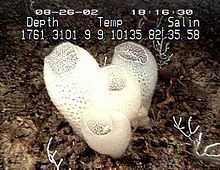Venus' Flower Basket
| Venus's Flower Basket | |
|---|---|
 | |
| Scientific classification | |
| Kingdom: | Animalia |
| Phylum: | Porifera |
| Class: | Hexactenellida |
| Order: | Lyssacinosidea |
| Family: | Euplectellidae |
| Genus: | Euplectella |
| Species: | E. aspergillum |
| Binomial name | |
| Euplectella aspergillum Owen, 1841 | |
The Venus's Flower Basket, or Euplectella aspergillum is a hexactinellid sponge in the phylum Porifera inhabiting the deep ocean. In traditional Asian cultures, this particular sponge (in a dead, dry state) was given as a wedding gift because the sponge symbiotically houses two small shrimp, a male and a female, who live out their lives inside the sponge. They breed, and when their offspring are tiny, the offspring escape to find a Venus Flower Basket of their own. The shrimp inside the basket clean it and, in return, the basket provides food for the shrimp by trapping it in its tissues and then releasing wastes into the body of the sponge for the shrimp. It is also speculated that the bioluminescent light of bacteria harnessed by the sponge may attract other small organisms which the shrimp eat.
They were also extremely popular in Victorian England, and one could easily fetch five guineas, equivalent to over £500 today.
Optical fibers and solar cells
The glassy fibers that attach the sponge to the ocean floor, 5-20 cm long and thin as human hair, are of interest to fiber optics researchers. The sponge extracts silicic acid from seawater and converts it into silica, then forms it into an elaborate skeleton of glass fibers. Other sponges such as the orange puffball sponge (Tethya aurantium) can also produce glass biologically. The current manufacturing process for optical fibers requires high temperatures and produces a brittle fiber. A low-temperature process for creating and arranging such fibers, inspired by sponges, could offer more control over the optical properties of the fibers. These nano-structures are also potentially useful for the creation of more efficient, low-cost solar cells.
Material strength
These sponges skeletons have complex geometric configurations, which have been extensively studied for their stiffness, yield strength, and minimal crack propagation. An aluminum tube (aluminum and glass have similar elastic modulus) of equal length, effective thickness, and radius, but homogeneously distributed, has 1/100th the stiffness.
References
- William McCall, AP (August 20, 2003). "Glassy sponge has better fiber optics than man-made".
- Joanna Aizenberg et al. PNAS 2004. "Biological glass fibers: Correlation between optical and structural properties" (PDF).
- Kevin Bullis (Nov./Dec. 2006). "Silicon and Sun". Technology Review.